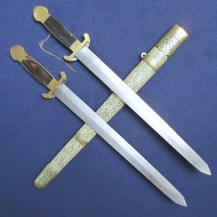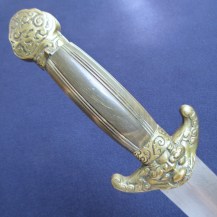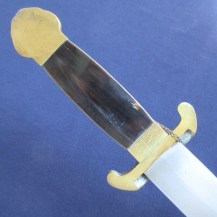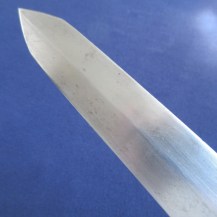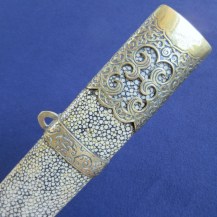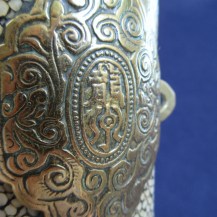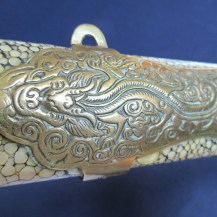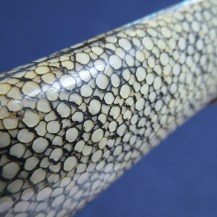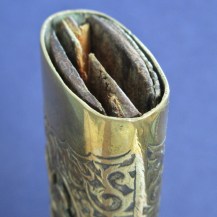Chinese Shuangjian Double Shortswords, Late 19th Century
Two straight, spear-pointed blades with flattened diamond cross-section, each with cast brass hilt and pommel, horn grips, both fitting together into a wooden scabbard covered with smoothed rayskin, with five cast brass fittings, two with fixed hanging rings. A fine brass chain is attached to a loop on the pommel of one of the swords, the other pommel has the same loop but no attached chain. Blade length 16.5 inches, overall length of each sword 22 inches.
The hilt of each sword depicts a taotie or ‘greedy glutton’, a Chinese mythological monster which was one of the ‘Four Perils’, lacking a lower jaw to emphasise its insatiable hunger. Like the lion often used on European swords, the taotie symbolized both threat towards enemies and protection of one’s own. The pommel is cast with a foliate pattern, and the scabbard fittings with a dragon motif framed by a Greek key or ‘rolling thunder’ pattern and more foliate designs.
Jians were commonly worn in China during the Qing period. Shuangjian (雙劍) literally means "double jian", and described two jians mounted into half hilts that both fit into the single scabbard side-by-side to appear as one. Dual wielding of them was relatively common in the quite flamboyant warrior culture of the period, making shuangjian a more convenient way to carry the pair. They are typically shorter than single jians.
Travellers to China found jians to be interesting and portable souvenirs, which led to a growing number of pieces made purely to sell to the tourist trade towards the end of the 19th century, including miniature versions. Both practical and tourist jian vary greatly in materials and workmanship, making them difficult to tell apart.
The blades are clean, with some polishing marks and areas of light patination. Some casting imperfections on the brass fittings. There is some movement to the pommel on one sword (without the chain). The wooden divider in the scabbard sits between the blades - this quite thin and has been chipped slightly at the mouth. One should take care when sheathing the blades not to scrape against the divider.


